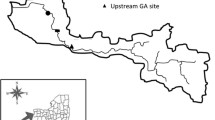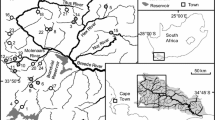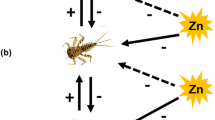Abstract
Predatory species have been introduced to habitats spanning a wide range of environmental conditions. To better understand the consequences of predation in natural communities we need to examine how variations in abiotic factors modify the influence of predation. The effects of introduced predators may vary amongst habitats if natural disturbance affects the abundance and taxonomic composition of consumers and their resources, or the predator alters recolonisation after disturbance. We tested whether a bed-moving disturbance altered subsequent interactions involving native and introduced predatory fish, invertebrate grazers and algae in experimental channels within a New Zealand stream. Disturbance reduced the abundance of invertebrates by 84%, and induced mortality of Conoesucidae caddisflies. However, the relative abundance of taxa changed little immediately following the disturbance. Invertebrate communities recovered following disturbance in fishless channels and those with native galaxiids (Galaxias vulgaris), and were almost indistinguishable from undisturbed fishless controls after 2 weeks. Invertebrate abundance declined and algal abundance increased in channels with exotic brown trout (Salmo trutta) and their effect was strongest in previously disturbed channels. However, predators and disturbance only had interactive effects on grazer emigration rates. Trout affected grazers through direct consumption (e.g. Conoesucidae caddisflies), and induced higher emigration rates of grazers from channels via drift (e.g. the mayfly Deleatidium). The effects of predatory trout and galaxiids combined differed in disturbed and stable channels. The observed combined effects of predatory trout and galaxiids on invertebrate grazers were lower than expected in stable channels partly due to low emigration rates of Conoesucidae, whereas emigration of grazers was higher than expected in the disturbed channels. The biomass of algae was higher than expected in disturbed channels with both predators. Collectively, our results indicate that predator substitutability and the non-lethal effects of introduced predators varied depending on disturbance history, but their effects on the biomass of grazers and algae did not.




Similar content being viewed by others
References
Al Shaw E, Richardson JS (2001) Direct and indirect effects of sediment pulse duration on stream invertebrate assemblages and rainbow trout (Oncorhynchus mykiss) growth and survival. Can J Fish Aquat Sci 58:2213–2221
Allan JD (1995) Stream ecology. Kluwer, Dordrecht
Biggs BJF (1996) Patterns in benthic algae in streams. In: Stevenson JR, Bothwell ML, Lowe RL (eds) Algal ecology. Academic Press, San Diego, Calif., pp 31–56
Byers JE (2002) Physical habitat attributes mediate biotic resistance to non-indigenous species invasion. Oecologia 130:146–156
Cadwallader PL (1975) Feeding relationships of galaxiids, bullies, eels and trout in a New Zealand river. Aust J Mar Freshwater Res 26:299–316
Connell JH (1975) Some mechanisms producing structure in natural communities: a model and evidence from field experiments. In: Cody ML, Diamond JM (eds) Ecology and evolution of communities. Belknap, Cambridge, Mass., pp 460–490
Cooper SD, Walde SD, Peckarsky BL (1990) Prey exchange rates and the impact of predators on prey populations in streams. Ecology 71:1503–1514
Crowl TA, Townsend CR, McIntosh AR (1992) The impact of introduced brown and rainbow trout in native fish: the case of Australasia. Rev Fish Biol Fish 2:217–241
Dahl J (1998) Effects of a benthivorous and a drift-feeding fish on a benthic stream assemblage. Oecologia 116:426–432
Dahl J, Greenberg L (1996) Impact on stream benthic prey by benthic and drift feeding predators: a meta-analysis. Oikos 77:177–181
Death RG (1996) The effect of patch disturbance on stream invertebrate community structure: the influence of disturbance history. Oecologia 108:567–576
Death RG, Winterbourn MJ (1995) Diversity patterns in stream benthic invertebrate communities: the influence of habitat stability. Ecology 76:1446–1460
Diehl S, Cooper SD, Kratz KW, Nisbet RM, Roll SK, Wiseman SW, Jenkins TM (2000) Effects of multiple, predator-induced behaviors on short-term producer-grazer dynamics in open systems. Am Nat 156:293–313
Dukes JS, Mooney HA (1999) Does global change increase the success of biological invaders? Trends Ecol Evol 14:135–139
Elliott JM, Persson L (1978) The estimation of daily rates of food consumption for fish. J Anim Ecol 47:977–991
Englund G (1997) Importance of spatial scale and prey movements in predator caging experiments. Ecology 78:2316–2325
Flecker AS, Townsend CR (1994) Community-wide consequences of trout introduction in New Zealand streams. Ecol Appl 4:798–807
Forrester GE (1994) Influences of predatory fish on the drift dispersal and local density of stream insects. Ecology 75:1208–1218
Forrester GE, Dudley TL, Grimm NB (1999) Trophic interactions in open systems: effects of predators and nutrients on stream food chains. Limnol Oceanogr 44:1187–1197
Marks JC, Power ME, Parker MS (2000) Flood disturbance, algal productivity, and interannual variation in food chain length. Oikos 90:20–27
Matthaei CD, Townsend CR (2000) Long-term effects of local disturbance history on mobile stream invertebrates. Oecologia 125:119–126
Matthaei CD, Uehlinger E, Frutiger A (1997) Response of benthic invertebrates to natural versus experimental disturbance in a Swiss prealpine river. Freshwater Biol 37:233–248
McIntosh AR (2000a) Habitat- and size-related variations in exotic trout impacts on native galaxiid fishes in New Zealand. Can J Fish Aquat Sci 57:2140–2151
McIntosh AR (2000b) Aquatic predator-prey interactions. In: Collier KJ, Winterbourn MJ (eds) New Zealand stream invertebrates: ecology and implications for management. New Zealand Limnological Society, Christchurch, pp 125–156
McIntosh AR, Townsend CR (1994) Interpopulation variation in mayfly anti-predator tactics: differential effects of contrasting predatory fish. Ecology 75:2078–2090
McIntosh AR, Townsend CR (1995) Contrasting predation risks presented by introduced brown trout and native common river galaxias in New Zealand streams. Can J Fish Aquat Sci 52:1821–1833
McIntosh AR, Townsend CR (1996) Interactions between fish, grazing invertebrates and algae in a New Zealand stream: a trophic cascade mediated by fish-induced changes to grazer behaviour? Oecologia 108:174–181
Menge B, Olson AM (1990) Role of scale and environmental factors in regulation of community structure. Trends Ecol Evol 5:52–57
Menge B, Sutherland JP (1987) Community regulation: variation in disturbance, competition, and predation in relation to environmental stress and recruitment. Am Nat 130:730–757
Moyle PB, Light T (1996) Biological invasions of fresh water: empirical rules and assembly theory. Biol Conserv 78:149–161
Nakano S, Miysaka H, Kuhara N (1999) Terrestrial-aquatic linkages: riparian arthropod inputs alter trophic cascades in a stream food web. Ecology 80:2435–2441
Nystrand O, Granström A (2000) Predation on Pinus sylvestris seeds and juvenile seedlings in Swedish boreal forest in relation to stand disturbance by logging. J Appl Ecol 37:449–463
Nyström P, McIntosh AR, Winterbourn MJ (2003) Top-down and bottom-up processes in grassland and forested streams. Oecologia (in press)
Peckarsky BL (1983) Biotic interactions or abiotic limitations? A model of lotic community structure. In: Fontaine III TD, Bartell SM (eds) Dynamics of lotic ecosystems. Ann Arbor Science, Mich., pp 303–323
Pickett STA, White PS (1985) The ecology of natural disturbance and patch dynamics. Academic Press, San Diego, Calif.
Poff NL, Ward JV (1995) Herbivory under different flow regimes: a field experiment and test of a model with a benthic stream insect. Oikos 71:179–188
Power ME (1990) Effects of fish on river food webs. Science 250:411–415
Scrimgeour GJ, Winterbourn MJ (1987) Diet, food resource partitioning and feeding periodicity of two riffle-dwelling fish species in a New Zealand river. J Fish Biol 31:309–324
Scrimgeour GJ, Davidson RJ, Davidson JM (1988) Recovery of benthic macroinvertebrate and epilithic communities following a large flood, in an unstable, braided, New Zealand river. N Z J Mar Freshwater Res 22:337–344
Sih A, Englund G, Wooster D (1998) Emergent impacts of multiple predators on prey. Trends Ecol Evol 13:350–355
Sokol-Hessener L, Schmitz O (2002) Aggregate effects of multiple predator species on a shared prey. Ecology 83:2367–2372
Thomson JR (2002) The effects of hydrological disturbance on the densities of macroinvertebrate predators and their prey in a coastal stream. Freshwater Biol 47:1333–1351
Thomson JR, Lake PS, Downes BJ (2002) The effect of hydrological disturbance on the impact of a benthic invertebrate predator. Ecology 83:628–642
Townsend CR (1991) Exotic species management and the need for a theory of invasion ecology. N Z J Ecol 15:1-3
Townsend CR, Scarsbrook MR, Dolédec S (1997) The intermediate disturbance hypothesis, refugia, and biodiversity in streams. Limnol Oceanogr 42:938–949
Townsend CR, Thompson RM, McIntosh AR, Kilroy C, Edwards E, Scarsbrook MR (1998) Disturbance, resource supply, and food-web architecture in streams. Ecol Lett 1:200–209
Wellborn GA, Skelly DK, Werner EE (1996) Mechanisms creating community structure across a freshwater habitat gradient. Annu Rev Ecol Syst 27:337–363
Winterbourn MJ (1997) New Zealand mountain stream communities: stable yet disturbed? In: Streit B, Städler T, Lively CM (eds) Evolutionary ecology of freshwater animals. Birkhäuser, Basel
Winterbourn MJ (2000) Feeding ecology. In: Collier KJ, Winterbourn MJ (eds) New Zealand stream invertebrates: ecology and implications for management. New Zealand Limnological Society, Caxton Press, Christchurch, pp 100–124
Winterbourn MJ, Gregson KLD, Dolphin CH (2000) Guide to the aquatic insects of New Zealand. Bull Entomol Soc N Z 13
Wooster DE, Sih A, Englund G (1997) Prey dispersal and predator impacts on stream benthic prey. In: Streit B, Städler T, Lively CM (eds) Evolutionary ecology of freshwater animals. Birkhäuser, Basel, pp 89–116
Wootton JT, Parker MS, Power MS (1996) Effects of disturbance on river food webs. Science 273:1558–1560
Zhang Y, Malmqvist B, Englund G (1998) Ecological processes affecting community structure of blackfly larvae in regulated and unregulated rivers: a regional study. J Appl Ecol 35:673–686
Acknowledgements
We are grateful to members of the Freshwater Ecology Research Group, who helped install and terminate the experiment. The manuscript benefited from comments by Mike Winterbourn, Scott Wissinger and two anonymous reviewers. We thank Per-Erik Isberg for statistical advice. This study was financed by a post-doctoral fellowship from Wenner-Gren foundations to P. N. and research grants from the Department of Zoology, University of Canterbury to A. R. M.
Author information
Authors and Affiliations
Corresponding author
Rights and permissions
About this article
Cite this article
Nyström, P., McIntosh, A.R. Are impacts of an exotic predator on a stream food web influenced by disturbance history?. Oecologia 136, 279–288 (2003). https://doi.org/10.1007/s00442-003-1250-3
Received:
Accepted:
Published:
Issue Date:
DOI: https://doi.org/10.1007/s00442-003-1250-3




